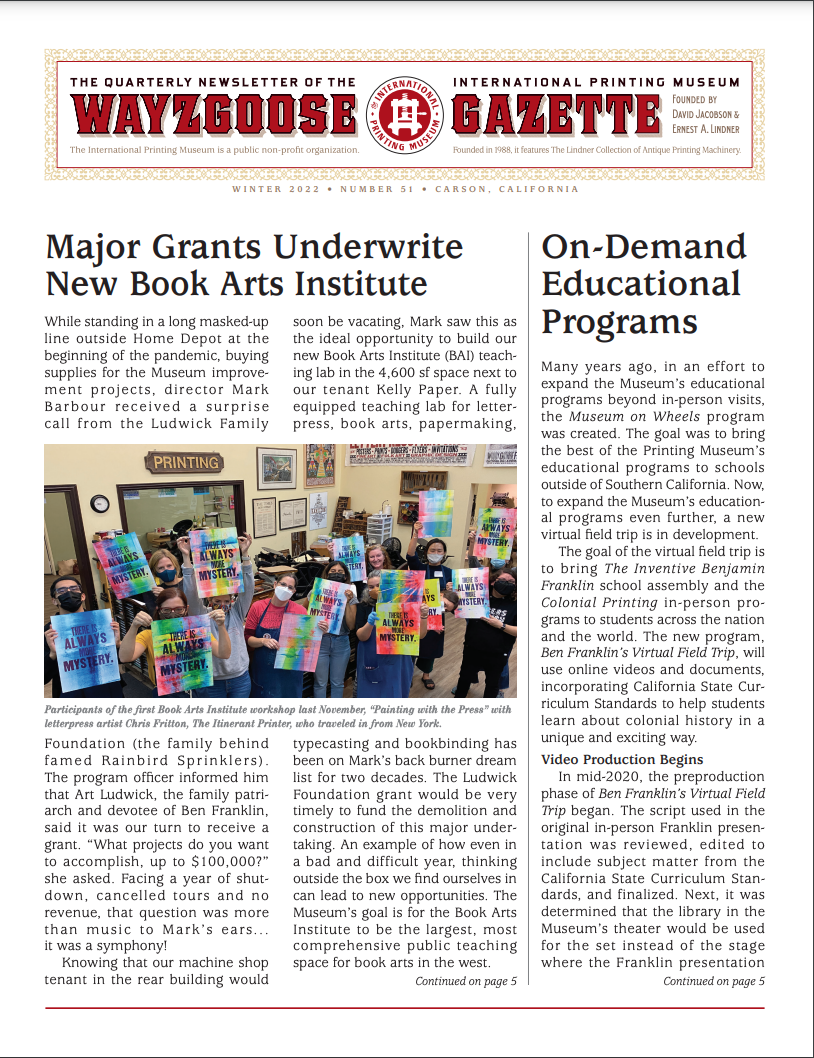PRINTERS AND PANDEMICS: PART I
/PRINTERS AND PANDEMICS: PART I
A book first published in 1721 is currently being reprinted. Since the COVID-19 outbreak in Britain, it’s been hard to get your hands on a copy of Daniel Defoe’s A Journal of the Plague Year.
The name Defoe may sound familiar. He’s the author of other fictional accounts of calamity and woe such as Robinson Crusoe and Moll Flanders.
When the Black Death once again threatened the European Continent in 1721, DeFoe decided to write an account of the plague of 1665 to alert people to what was about to happen. A Journal of the Plague Year is a story of “panic buying, mysterious illness, quack remedies, and fake news.”
The book is no doubt a work of fiction since DeFoe was only five years old when the plague hit London in 1665. It’s thought he used his uncle’s stories and memories of the epidemic to write the book. Some of the accounts in his work may sound very familiar to us today.
Pandemic Parallels
As of the writing of this blog, much of Europe and North America are under “stay at home” orders. In Defoe’s account, we learn of a house in Whitechapel that was “shut up for the sake of one infected maid.” According to Defoe, occupants of the house “obtained no liberty to stir, neither for air or exercise, forty days.”
We also learn of the watchmen who were posted at the doors of houses that were infected by the plague. They were there to get needed supplies for the occupants and to prevent the occupants from leaving.
DeFoe also describes the dead-cart and the bellman that would call out several times, “Bring out your dead.”
We know about these events due to the work of the publisher of Defoe’s book. If you look closely at the bottom of the title page of the original book (see above image), you’ll see, “Printed for E. Nutt, 1722.”
John and Elizabeth Nutt were printers and booksellers in London in the early 18th century. John died in 1716, and Elizabeth took over the printing business and continued to be listed as a printer on title pages until 1741.
As her business grew, Elizabeth brought her daughters, Catherine, Sarah, and Alice, into the business where they manage various bookstores and newspaper outlets around London.
A recent essay from Sharon Achinstein, Plagues and Publication: Ballads and the Representation of Disease in the English Renaissance, also echoes situations familiar to us today. She describes how the plague fractured the community. “Courts closed, trade, theaters, and fairs were ordered to cease functioning.” She says, “The precautions ordered that citizens become prisoners in their own houses, left to live or die on their own.”
Engravings as a Record of the Plague
We also learn about events that took place during the plague due to the work of engravers like Nathaniel Parr. His engraving, seen here, shows three men loading plague victims from the street onto a cart. Two of the men are smoking pipes to protect themselves. In the background to the right, a figure with a bundle over his shoulder is walking under an arch.
Bookseller and publisher Thomas Astley published this image. He was located at the Rose, St. Paul’s Churchyard, London, where booksellers overflowing from Fleet Street were known to gather.
The work of Nutt and Parr are examples of print as a record of the event, but print also shaped the event.
Printing During the Plague
Printing in London predates the plague of 1665 by nearly 200 years. William Caxton, an English printer, translator, and publisher, learned how to print while working in Cologne in 1470. Upon returning to his native England from Germany in 1476, Caxton established England’s first-ever printing press in the almonry of Westminster Abbey Church.
Caxton was a prolific printer printing nearly all the English literature available to him in his time, including the first printed edition of Geoffrey Chaucer’s The Canterbury Tales.
As printing was a well-established industry in 1665 London, you can imagine the number of handbills, broadsides, and publications that contained opinions about how and why the city was enduring yet another plague. To be honest, the dissemination of fake-news was equal to or greater than today’s social media posts.
According to Achinstein, ballads, such as the one seen here, were thought to help spread the plague. Prominent Puritan William Prynne thought that “Such songs, such poems as these are abundantly condemned, as filthy and unchristian defilement, which contaminate the souls, effeminate the minds, deprave the manners, of those that hear or sing them enticing them to lust…”
Other Puritans, like Thomas Vincent, believed that, because Londoners were leading lives of debauchery, God used the plague to serve as a warning to the unbelievers.
Some believed that the paper that the ballads were printed on helped spread the plague. This idea comes from the fact that people knew the disease would spread from place to place and, since the distributors of the ballads also moved from place to place, perhaps the paper with the evil printed words was the cause of the pestilence.
Other printed works served as a reminder to the sick to remain in their houses. There were engravings of new plague hospitals with guarded gates and gallows for offenders against the quarantine.
Without a doubt, the most important printed works to come out of the plague of 1665 were the Bills of Mortality. These were large printed broadsides with lists of the individuals who had recently died.
Plague data were first published as weekly broadsides during the epidemic of 1596-1598. They continued to be printed on and off for through the 19th century.
To prepare the bills, took a lot of work. First, parish clerks compiled a weekly count of the burials in his parish. He then sent his report to his guild, the London Company of Parish Clerks, who would compile a report for the Lord Mayor. The report was then used to impose quarantines and board up houses.
Some of the printed Bills of Mortality were nailed to posts for public consultation. Others were available for the cost of a penny. Some extant copies of the bills have been found folded in such a way to allow an individual to fit the broadside into a jacket pocket. This would be helpful when traveling around London. Based on the information, you could avoid areas of the city that were heavily impacted by the plague.
To keep control of all the records and to make sure the bills were published promptly, in 1625, the Company of Parish Clerks was authorized to set up their own printing press. If you look closely at the Bill of Mortality above, you’ll see the printer to the Company of Parish Clerks was ‘E. Cotes living in Aldersgate-street.’
Ellen Cotes was the widow of printer Richard Cotes. Ellen took over the shop when Richard died in 1652 and continued printing until at least 1670. She had a good size shop with three presses, nine pressmen, and two apprentices.
London’s Lord Have Mercy Upon Us
In addition to the official Bills of Mortality, there were other broadsides that were printed and disseminated throughout London during the plague of 1655. London’s Lord Have Mercy Upon Us broadsides contained poetry and medical prescription information along with engravings and statistical information. The stats were gleaned from the contemporaneous Bills of Mortality.
The issue of London’s Lord Have Mercy Upon Us pictured here contains a recipe to keep one from infection.
A cheap medicine to keep from infection
“Take a pint of new milk, and cut two cloves of garlic very small, put it in the milk, and drink it in the morning fasting, and it preventith from infection.”










